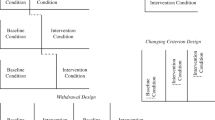Abstract
Precision Teaching's unique legacy from B. F. Skinner was the monitoring system of rate of response and the cumulative response recorder. This legacy is unique because the other instructional systems derived from Skinner's work do not use his monitoring method exclusively. Rate of response, cumulative recording and their extension to Precision Teaching's standard celeration charting are briefly described. In addition, Precision Teaching's nature, history, costs, distribution, inductive data-base, and academic base are briefly described. Skinner's legacy to education was a sound behavioral scientific base and his unique legacy to Precision Teaching was self-monitoring for real time decision making by learners and teachers.
Similar content being viewed by others
References
Albrecht, P. L. (1984).Summary of ten major school Precision Teaching programs Unpublished Doctoral Dissertation, University of Kansas.
All, P. (1977).From get truckin' to Jaws, students improve their learning picture. Unpublished master's Thesis, University of Kansas.
Barrett, B. H. (1987). Drifting? Course? Destination?: A review of research methods in applied behavior analysis: Issues and advances.The Behavior Analyst, 10, 253–276.
Beck, R. J. (1976).Report for the Office of Education Dissemination Review Panel, 1976, Special Education. Great Falls Public Schools, Precision Teaching Project: Great Falls, Montana.
Beck, R. J. (1981).High School Basic Skills Improvement Project: Validation Report for ESEA Title IV-C. Great Falls Public Schools, Precision Teaching Project: Great Falls, Montana.
Binder, C. V. (1988). Precision teaching: Measuring and attaining exemplary academic performance.Youth Policy, 10 [No. 7], 12–15.
Edwards, J. S. (1969).Precisely teaching children labelled learning disabled. Unpublished Doctoral Dissertation, University of Kansas.
Eshleman, J. W. (1990). The history and future of Precision Teaching.Journal of Precision Teaching, 7, (No. 2 Fall), 18–27.
Ferster, C. B. & Skinner, B. F. (1957).Schedules of Reinforcement. New York: Appleton-Century-Crofts.
Fink, E. R. (1968).Performance and Selection Rates of Emotionally Disturbed and Mentally Retarded Preschoolers on Montessori Materials. Unpublished Master's Thesis, University of Kansas.
Haughton, E. C. (1971). Great gains from small starts.Teaching Exceptional Children, 3, 141–146.
Johnson, K. R. (1989).Executive Summary. Seattle, Washington: Morningside Corporation.
Johnson, N. J. (1971).Acceleration of Inner-City Elementary School Pupils' Reading Performance. Unpublished Doctoral Dissertation, University of Kansas.
Johnston, J. M., & Pennypacker, H. S. (1980).Strategies and tactics of human behavioral research. Hillsdale, NJ: Erlbaum.
Keller, F. S. & Schoenfeld, W. N. (1950).Principles of Psychology. New York: Appleton-Century-Crofts.
Koenig, C. H. (1967).Precision Teaching with Emotionally Disturbed Children. Unpublished Master's Thesis, University of Kansas.
Koenig, C. H. (1971). The behavior bank: a system for sharing precise information.Teaching Exceptional Children, 3, 157.
Koenig, C. H. (1972).Charting the Future Course of Behavior. Unpublished Doctoral Dissertation, University of Kansas.
Lindsley, O. R. (1956). Operant conditioning methods applied to research in chronic schizophrenia,Psychiatric Research Reports, 5, 118–139.
Lindsley, O. R. (1960). Characteristics of the behavior of chronic psychotics as revealed by free-operant conditioning methods.Diseases of the Nervous System.21 (monograph supplement), 66–78.
Lindsley, O. R. (1962). A behavioral measure of television viewing.Journal of Advertising Research, 2, 2–12.
Lindsley, O. R. (1964). Direct measurement and prosthesis of retarded behavior.Journal of Education, 147, 62–81.
Lindsley, O. R. (1966). An experiment with parents handling behavior at home.A Johnstone Bulletin, 9, 27–36.
Lindsley, O. R. (1990a). Precision teaching: By teachers for children.Teaching Exceptional Children, Spring, 10–15.
Lindsley, O. R. (1990b). Our aims, discoveries, failures, and problem.Journal of Precision Teaching, 7 (No. 2, Fall), 7–17.
Lindsley, O. R., Koenig, C. H., Nichol, J. B., Kanter, D. B. & Young, N. A. (1971).Handbook of Precise Behavior Facts. Kansas City, Kansas: Precision Media. 2 volumes. Massachusetts.
Maloney, M., & Humphrey, J. E. (Interviewer). (1982). The Quinte Learning Center: A successful venture in behavioral education, an interview with Michael Maloney.The Behavioral Educator, 4, No. 1, 1–3.
McGreevy, P. (1981).Teaching and Learning in Plain English. Kansas, Missouri: Mcgreevy Publishing.
Pennypacker, H. S., Koenig, C. H., & Lindsley, O. R. (1972).Handbook of the standard behavior chart. Kansas City, KS: Precision Media.
Skinner, B. F. (1938).The behavior of organisms. Englewood Cliffs, NJ: Prentice-Hall.
Skinner, B. F. (1950). Are theories of learning necessary?Psychology Review, 57, 193–216.
Skinner, B. F. (1953).Science and human behavior. New York: Macmillan.
Skinner, B. F. (1956). A case history in scientific method.American Psychologist, 11, 221–233.
Skinner, B. F. (1976). Farewell, my lovely!Journal of the Experimental Analysis of Behavior, 25, 218.
Slezak, S. A. (1969).Two Years of Precisely Teaching with Orthopedically Handicapped Pupils. Unpublished master's thesis, University of Kansas.
Sokolove, H. (1978).Blueprint for PRODUCTive Classrooms. Shawnee Mission School District. ESEA Title IV-C. Kansas State Department of Education.
Spence, I. & Maloney, M. (1990).Educational computer software: What's out there? Presented at the 9th International Precision Teaching Conference, Boston, Massachusetts.
Starlin, A. (1971). Charting group and individual instruction.Teaching Exceptional Children, 3, 135–136.
Starlin, A. (1972). Sharing a message about curriculum with my teacher friends. In J. B. Jordan & L. S. Robbins (Eds.),Let's Try Doing Something Else Kind of Thing (pp. 13–19). Arlington, VA: Council for Exceptional Children.
Starlin, A. H. (1986).Survey of fifteen principals trained in Precision Teaching exploring their use of the standard celeration Chart. Unpublished doctoral dissertation, University of Kansas.
Starlin, C. M. (1970).The use of daily recording as an aid in teaching oral reading. Doctoral Dissertation, University of Oregon. [Dissertation Abstracts International, 1971,32, 812a (University Microfilms No. 71-16, 844). ]
Watkins, C. L. (1988). Project Follow Through: A story of the identification and neglect of effective instruction.Youth Policy, 10 [No. 7], 7–11.
West, R. P., Young, K. R., & Spooner, F. (1990). Precision teaching, an introduction.Teaching Exceptional Children, Spring, 4–9.
White, O. R. (1986). Precision teaching-Precision Learning.Exceptional Children, 52, 522–534.
Willis, B. (1974).Progress Report IV SST for Precise Educational Remediation for Managers of Specific Learning Disabilities. Child Service Demonstration Programs, State of Washington, P.L. 91–230 Part G.
Author information
Authors and Affiliations
Rights and permissions
About this article
Cite this article
Lindsley, O.R. Precision teaching's unique legacy from B. F. Skinner. J Behav Educ 1, 253–266 (1991). https://doi.org/10.1007/BF00957007
Accepted:
Issue Date:
DOI: https://doi.org/10.1007/BF00957007




